After joining Ligue 1 side Lorient from Belgian First Division A side KV Kortrijk in October 2020, centre-forward Terem Moffi (188cm/6’2”, 89kg/196lbs) played a key role for Les Merlus in their first season back in Ligue 1 since 2016/17 by contributing 14 goals and three assists to their survival push, helping Christophe Pélissier’s side to avoid relegation with a 16th place finish.
This season has been a more difficult one for Lorient and Moffi, however, and Les Merlus currently occupy one of Ligue 1’s two relegation spots, with the 22-year-old attacker enjoying a far less fruitful campaign, managing just three goals and three assists in his 21 appearances (1761 minutes) so far.
Despite the striker’s “woeful form”, as it’s been described by some, Moffi retains the backing of manager Pélissier, with the 56-year-old coach publicly declaring that the 22-year-old “keeps my confidence” despite his struggles in front of goal this season.
While Moffi’s scored just three goals this term — fewer than 52 other Ligue 1 players — he’s generated an xG of 7.6, per Statsbomb via FBRef, which ranks him 11th for xG among Ligue 1 players this season. So, it’s clear that he’s significantly underperforming in the goalscoring department based on the quality of chances he’s had. Last season, Moffi’s 14 goals, which ranked him as the joint-ninth top scorer in the league, came from an xG of 12.5 — which ranked eighth in the league and is pretty much in the same ballpark as the number of actual goals scored. On one hand, Moffi’s current xG underperformance is highly unlikely to continue at the same rate over the long term and you’d expect Moffi to score at a higher rate if he continues to avail of the same quality of chances but at the same time, Lorient need to do anything and everything they can to get the Nigerian attacker firing again as soon as possible, with relegation looming and the second half of the season now well underway.
Determining the root cause/causes of Moffi’s underperformance is tricky, as part of it can be chalked down to luck and part of it can also be the effect that such underperformance can have on a striker’s confidence, thus creating further underperformance. You’re dealing with people, after all, and people are complex; so, those working closely with Moffi are in a far better position to determine to what extent all of the different factors are weighing on the 22-year-old, creating the slump in form we see on the pitch. However, there are other key contributing factors that we can analyse from the outside to determine what’s going differently for Moffi this season, where he and Lorient are doing a good job of playing to his strengths and where they’re perhaps failing to do so enough.
In this tactical analysis and scout report, I hope to provide some insight into Moffi’s role within Pélissier’s strategy and tactics at Lorient to give an idea of what kind of player he actually is, before then moving on to provide some analysis of key strengths and weaknesses in his game to highlight what he may need to do more of and less of to maximise his potential, while determining why exactly Pélissier stands by the attacker despite his current run of form.
Positioning and movement
As already mentioned, Moffi is a centre-forward and he has primarily played as the right-forward in a 5-3-2 system this term and since the end of last season, while he’s frequently played as a lone striker as well during his time at Lorient. The Nigerian attacker is left-footed and scores the vast majority of his goals with his left foot. However, Moffi is comfortable with using his right foot too during passes, dribbles and for less challenging shots, so isn’t too predictable in that manner. Again, he clearly favours his left foot but has a limited degree of two-footedness, albeit limited, which is a strength to his game.
The striker likes to operate on the right side of attack, and so is suited to the right of a two-man partnership. Even when playing as a lone striker, it’s common to see Moffi favour the right side of attack to an extent, peeling away to the right when making runs in behind the opposition backline from where he can open his body up and curl shots towards the far corner of the net.
In general, Moffi thrives when played through with space to attack with the ball behind the opposition’s backline. He’s a very powerful runner with some similar traits to the likes of fellow Ligue 1 attacker Burak Yılmaz of Lille and EPL forward Romelu Lukaku of Chelsea, though performing to a lower level than those two at present, with Lukaku helping Inter to a Serie A title last season and Yılmaz firing Lille to Ligue 1 glory last term. Nevertheless, stylistically, Moffi is in the mould of those two attackers — not a target man, despite his size and strength — rather a powerful runner who loves to attack space and whose off-the-ball movement is key to his attacking potency.

A lot of Moffi’s goals last season came from situations in which he was played through in behind the opposition’s backline with space to burst into. He’s an excellent asset for his team in transition to attack because the opposition’s backline is generally higher in such situations, giving Moffi space to target with a run. The Nigerian scored a hat-trick versus Bordeaux late last season with all three goals coming on the counter. Figure 1 provides an example of the type of run it’s really common to see from Moffi — peeling away to the right and targeting space behind the backline.
The best pass for Moffi to receive is a pacey through pass like this that he can take into his stride, knocking it into space to follow it on, without having to slow down to get it under control first before then speeding back up. Moffi’s acceleration isn’t extremely impressive and as a result, if he doesn’t receive the pass into space while already running at speed, it can take him too long to speed up, giving the opposition defender enough time to catch him.
From here in figure 1, we see Moffi drive into the space behind the backline after receiving the ball while still running at pace, arrive into the box from the right and open his body up to curl the ball across goal. This is one of Moffi’s favourite shots and a very common way to see him approach goalscoring, with the Lorient man also regularly aiming to carry the ball past the opposition goalkeeper, usually while running across the box after the ‘keeper has rushed out. Again, Moffi’s acceleration isn’t too impressive but once at full speed, he is quite pacey for a big man. He is not agile but he’s capable of making small changes in direction while running at speed which when combined with his size, can deceive the opposition ‘keeper quite well and help him to carry the ball beyond the ‘keeper, leaving himself with an empty net. Moffi’s ability to regularly do this with success is a big positive to his game as a powerful runner who likes to attack space behind the backline and adds another element for the opposition ‘keeper to consider, along with his shooting ability itself.
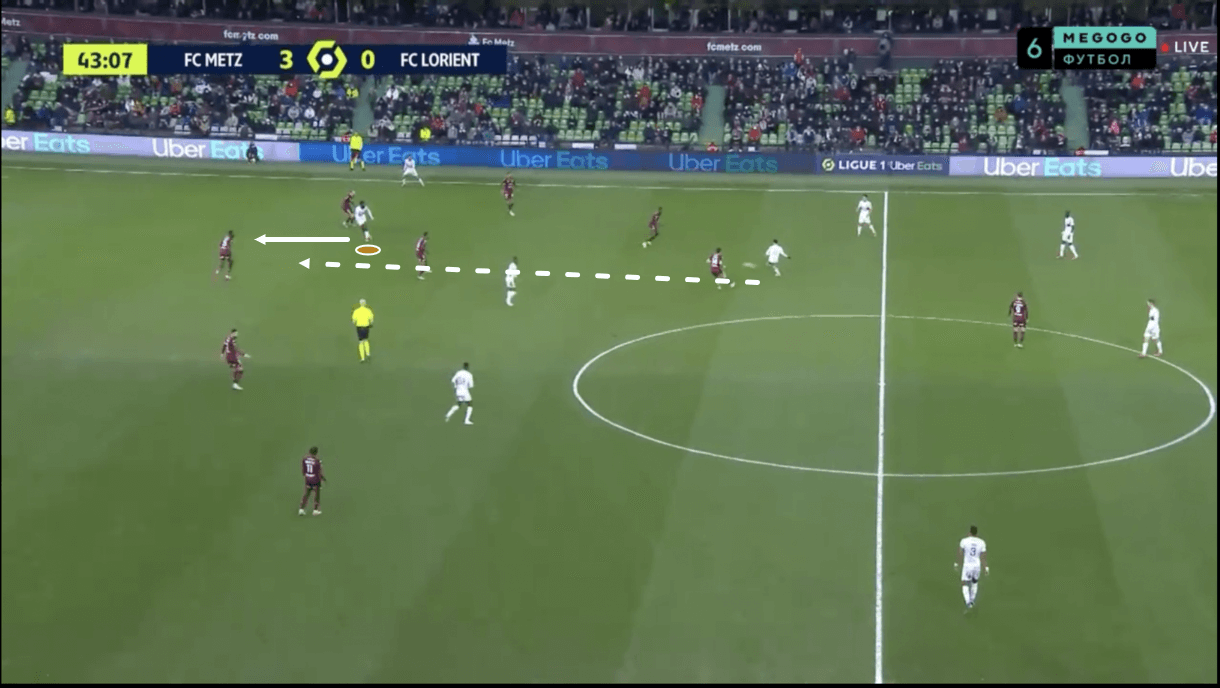
Moffi likes to hang about on the shoulder of the opposition defenders, seeking to take any possible chance to exploit space as it opens up behind the opposition backline. It’s common to see him target the channel between the opposition left-back and left centre-back or channel between the left centre-back and central centre-back if playing against a back three which we see an example of in figure 2.
He’ll initially face the passer and wait for their pass to be played, ideally at pace and just in front of him, into the channel he’s targeting with his run. As the ball runs through into his path, the striker will turn and begin building up speed to chase the ball into the channel and, all going well, get to top speed by the time he reaches the ball to power into the opposition box.
As mentioned, Moffi’s not very fast off the mark but once he does reach his top speed, he can be very difficult for defenders to control. His speed makes him difficult to catch while his size and strength makes him difficult to knock off the ball or even unbalance to a great extent. Moffi could work on how he turns after the ball has been played into his path with this move, as sometimes he’s a bit slow in turning to get from facing the passer to facing the opposition goal. However, his positioning, movement, eye for space and combination of pace and power once he manages to reach his top speed are all major positives for this part of his game, which again shows how dangerous Moffi can be from this position when driving into space.
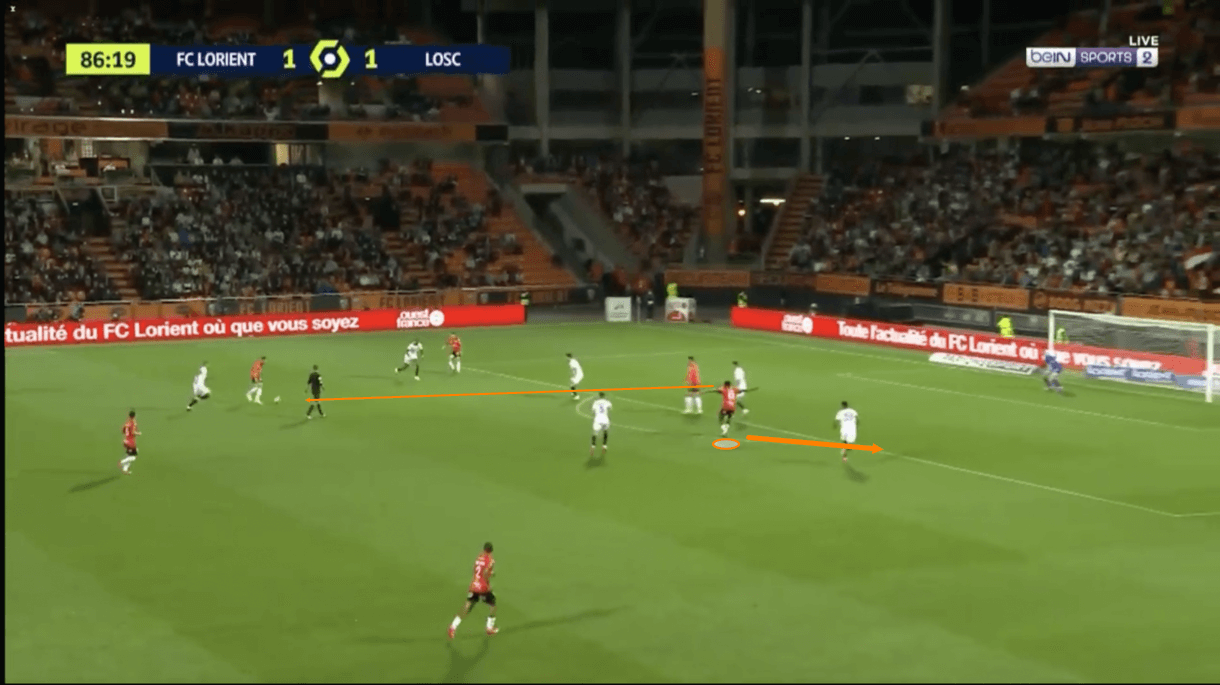
Figures 3-4 show an example of Moffi preparing himself to meet a cross. Firstly, in figure 3, we see Lorient have the ball in the left half-space, with Moffi occupying his typical right-forward position. As the ball carrier looks up from the left half-space, Moffi begins to peel away behind the opposition defenders towards the back post, from where he aims to make himself available for a headed opportunity, in space, out of the defenders’ eyeline.
This is some intelligent movement from the 22-year-old, who’d struggle to meet the ball to feet at this particular moment in time due to the potential angle of the pass and the number of bodies, including a teammate’s, directly in front of him. As a result, he opts to give the passer an option at the back post and pulls away intelligently to the defenders’ blindside, with Moffi also getting behind the defender running into the box from the edge of the area in figure 3.
Moffi’s aerial ability isn’t very good in general play; he’s not the target man that you want to be sending the ball long towards to escape pressure or with a view to holding up the play and helping the team to progress upfield. He doesn’t win many of his aerial duels and doesn’t boast a very impressive jump height, which works against him in aerial duels. However, his off-the-ball movement in the box can help him to get into dangerous positions to threaten via a headed shot and if nothing else, then Moffi will typically at least attract attention from some defenders towards him in this situation, potentially creating extra space for a teammate.
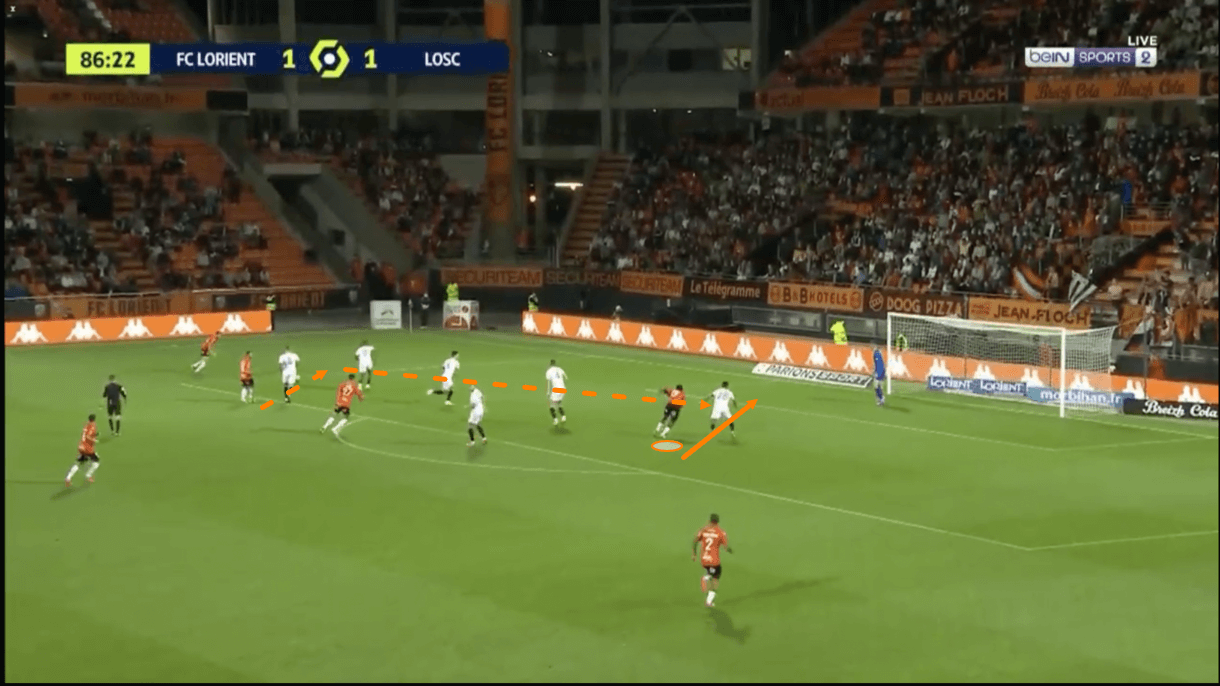
However, as this particular passage of play moves on into figure 4, we see that the ball carrier didn’t actually opt to cross the ball but instead played a through pass out to the overlapping wing-back. As he did so, Moffi changed the direction of his run and burst in front of the full-back he’d previously moved behind. In doing so — and by timing the movement so well — he set himself up for a great goalscoring chance from very close range, as the crosser could find Moffi with a low driven ball to the front post.
Even as the defender became aware of Moffi’s movement from behind him to the front here, there was nothing he could really do to stop the attacker as Moffi’s size made it difficult for the defender to compete with him physically by unbalancing or outmuscling him at all. This made life very difficult for the defender and highlights one of the big benefits of the Nigerian’s size and strength in the final third. Moffi is excellent at using his size and strength to hold his ground and keep himself in a good position — in this case, in front of the defender and in space to receive the low cross at the front post.
This well-timed, intelligent movement, combined with Moffi’s physical qualities highlights why defenders need to remain very diligent and aware about Moffi’s movements when playing against the 22-year-old, as he is a very observant player with quick reactions, who’s always difficult to stop once he gets going.
Moffi is very comfortable with finishing off low crosses like the one we see here. His first time finishing is a good quality in his repertoire and he generally demonstrates excellent off-the-ball movement and offensive positioning inside the penalty area to ensure he’s best placed to avail of the first-time goalscoring opportunities should they present themselves to him, with figure 4 showing a good in-game example of these qualities in the attacker’s game. This off-the-ball movement and intelligent positioning leads to some high-quality opportunities for Moffi, as evidenced by the relatively high xG he’s still boasting this season.
So, while Moffi’s finishing has not been on point this season, he’s still been getting into high-quality goalscoring positions regularly, which is very encouraging and will go some way to explaining why he retains Pélissier’s faith. Moffi’s non-penalty xG per shot of 0.19 in the last year actually ranks him in the 90th percentile for this metric among forwards from Europe’s top five leagues, per Statsbomb via FBRef, highlighting his general intelligent shot selection, movement and positioning. If he continues to move and position himself as he is, I’m confident a similar goalscoring rate to the one that he showed last season isn’t a million miles away.
Backing into defenders
Our next section of analysis focuses on Moffi’s ability to play with his back to goal and to use his size and strength versus opposition defenders. This is something he’s done, at times, to good effect but I believe this is a major potential area of improvement within his game, as the 22-year-old has got great size and strength that he could really use to bully defenders a lot more than he has been, which could make him an even bigger threat in the future.
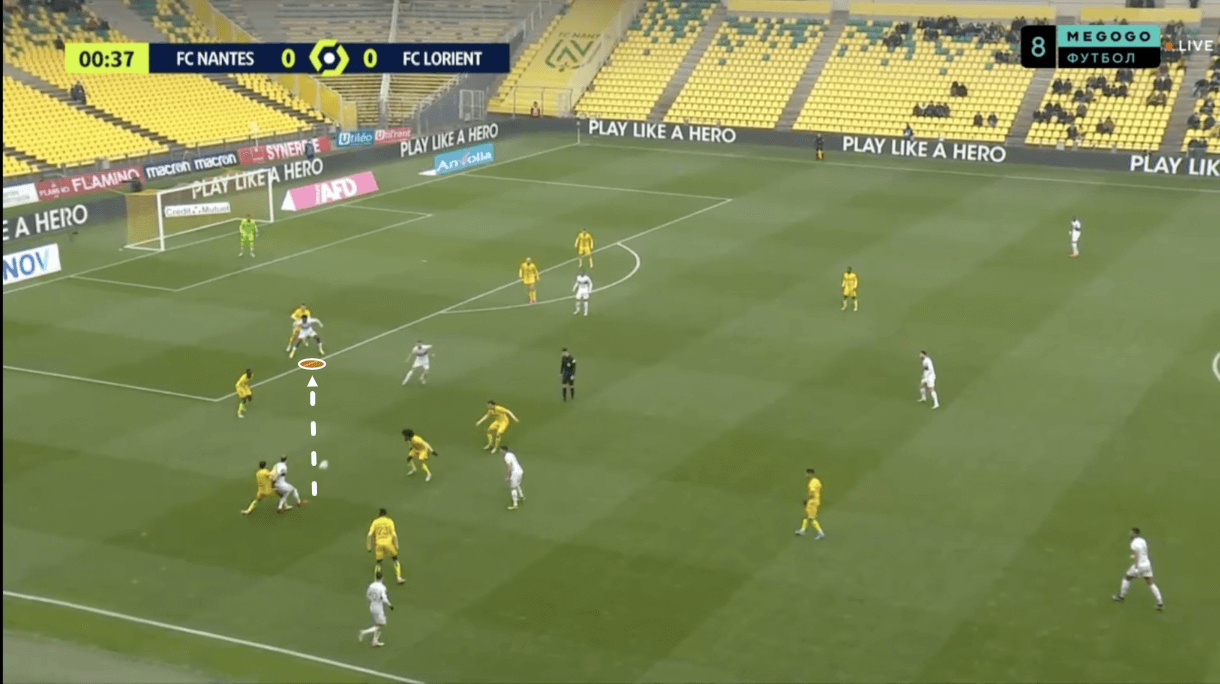
As we observed at the end of the previous section and as we see in figures 5-6 here, it can be difficult for defenders to compete with Moffi physically when he does play with his back to them and figure 5 shows an example of the attacker playing with his back too goal during the chance creation phase, essentially acting as a wall that his teammate on the left wing can bounce the ball off while looking to play into the centre of the pitch.
On this occasion, we see how Moffi sets himself really well with a wide stance and low hips which goes some way to making himself even more difficult for the defender behind him to move. His wide stance gives himself a more solid base than he’d otherwise have while he can use his low hips to keep the defender away while backing into him, preventing the opposition player from getting too tight while contesting this duel. This is an excellent example of how Moffi can control a ground duel with his back to goal and physically dominate the defender.
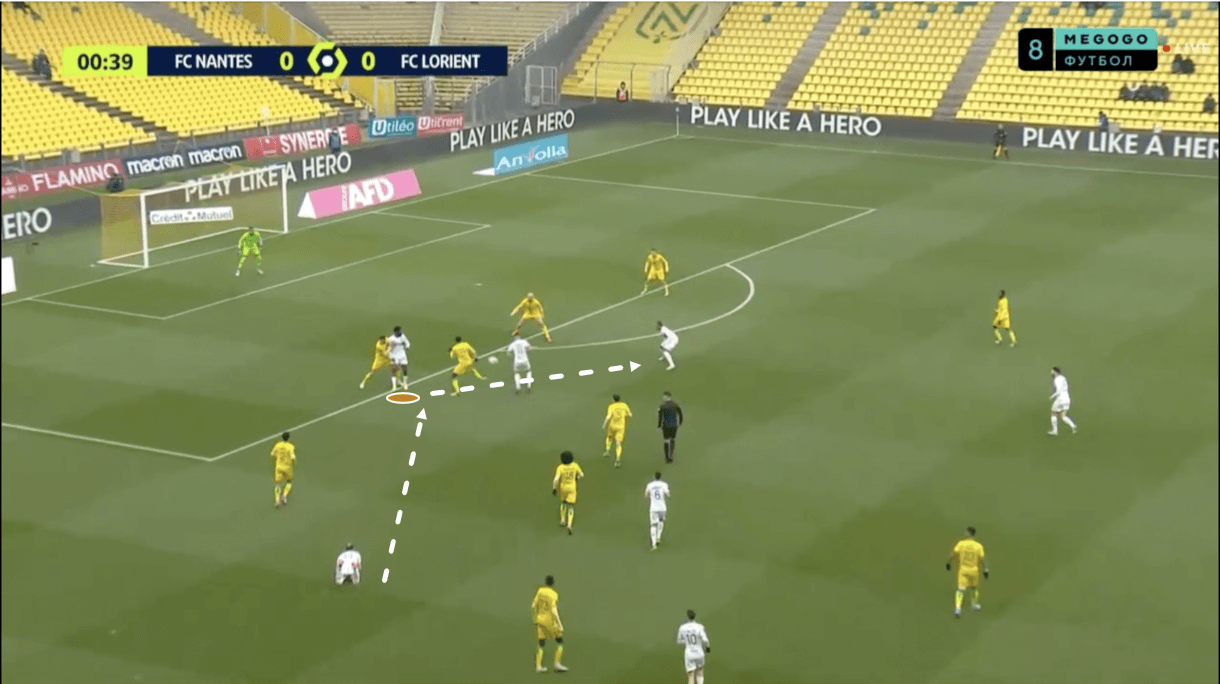
As play moves on into figure 6 here, we see that as Moffi receives, he successfully directs the ball into the attacker occupying the always dangerous zone 14 just on the edge of the area, with that Lorient man enjoying plenty of time and space to create something from there. The Nigerian attacker played a key role in this move thanks to his physicality and well-executed pass.
In general, Moffi’s technical passing ability isn’t much to write home about but he’s more than capable of pulling off safer short passes to link play between teammates like the one we see in the images above. You shouldn’t look to Moffi to play a defence-splitting pass, as this just isn’t his game at all, which we’ll come onto. However, if you look to use him as a wall to bounce the ball off into a better area or just link play inside the final third, then this is a much better way of utilising the 22-year-old and a role he’s capable of performing to a decent level.
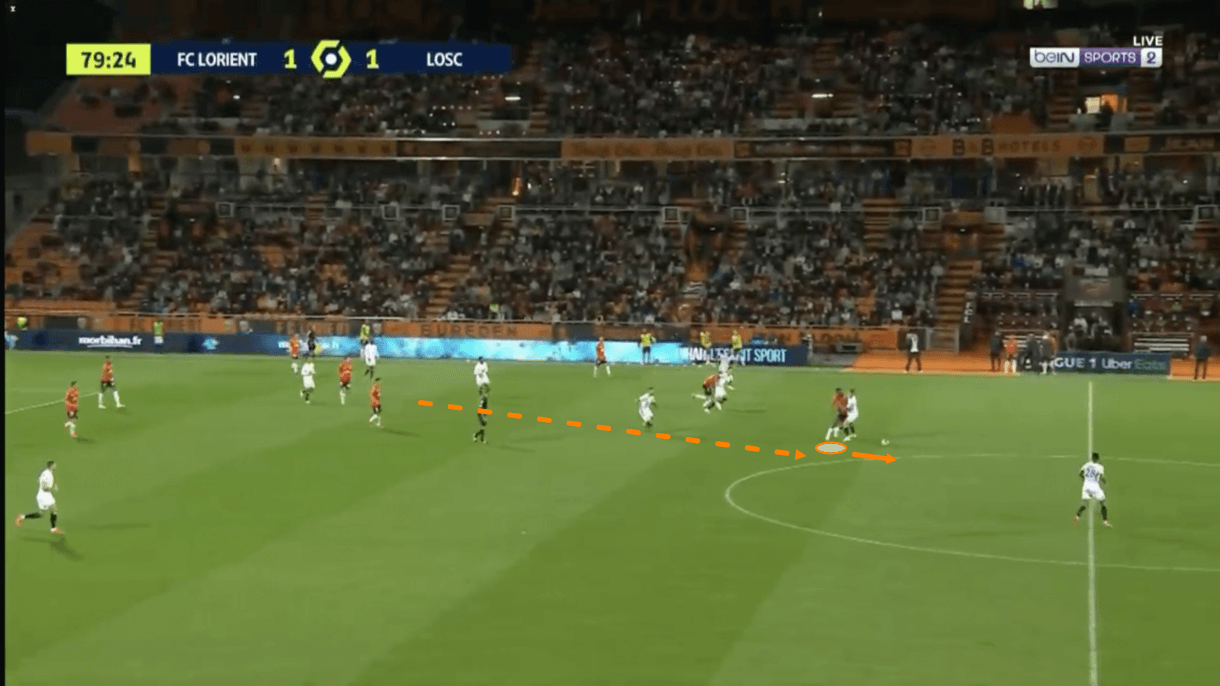
Another example of when we might see Moffi backing into players is shown in figure 7. Here, Lorient are just transitioning to attack, with Moffi performing his signature turn from facing the passer to facing the opposition goal while chasing a driven through pass into space behind the backline which we discussed earlier in this scout report. However, on this occasion, Moffi is brought down by the opposition defender marking him, with the defender essentially opting to bring the attacker down on the halfway line rather than let him build up speed and get moving towards their goal. This was probably a wise move from someone who’s well aware of the danger that the Lorient attacker poses when he gets a full head of steam going.
This is a rare example of Moffi forcing a foul out of a defender while turning, with the Nigerian having drawn just 0.72 fouls per 90 in the last calendar year, per Statsbomb via FBRef, which ranks him in just the fourth percentile for ‘fouls drawn’ among forwards from Europe’s top five leagues in this time period.
I wouldn’t expect Moffi to rank extremely highly in this area as he’s not the tricky dribbler who’s going to be taking on defenders in 1v1s regularly and looking to carry the ball past them, thus drawing more fouls simply through being a large volume dribbler. However, if Moffi used his size and strength more by backing into defenders when the ball is being played to him either in the final third or in a position like the one we see him occupying in figure 7, he could either find himself dominating defenders more and beating them more easily — relying less on his acceleration to get past them and more on his physicality to turn them — or drawing more fouls, which could be of use to his side in certain situations.
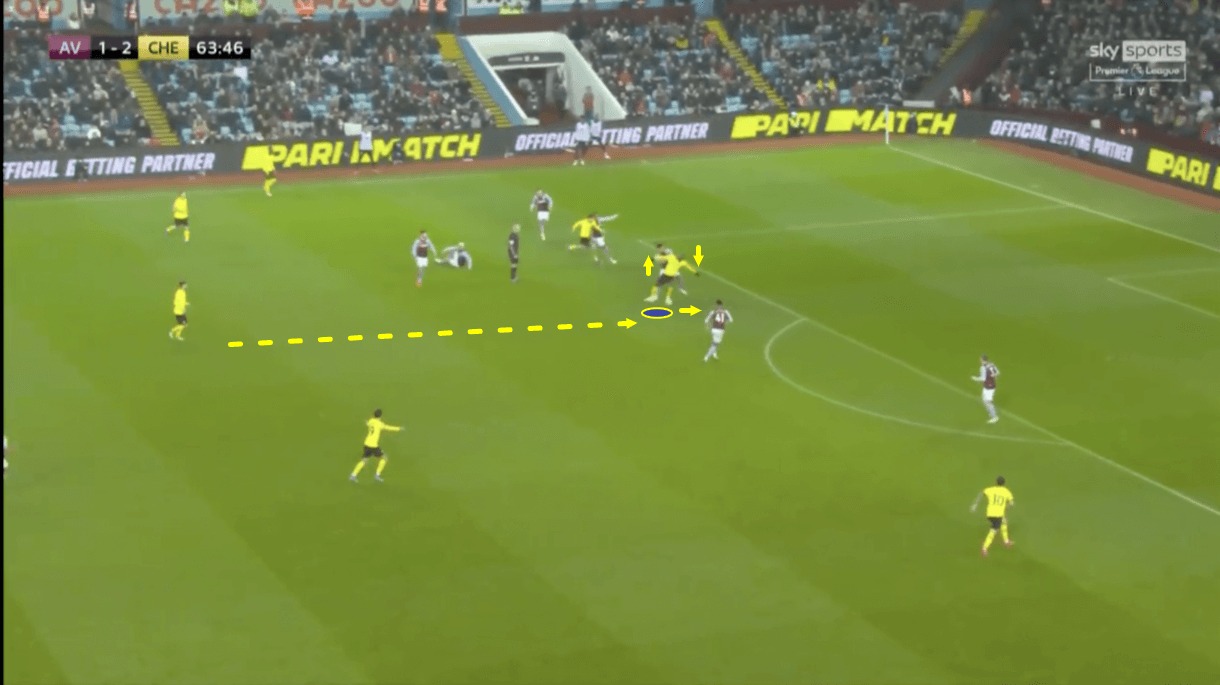
Figure 8 shows an example of Chelsea’s Romelu Lukaku — a player who shares some similar stylistic traits with Moffi — performing a signature action of his which often leads to either turning the defender via his size, strength and technique to find himself through on goal or drawing a foul, as was the case in this particular passage of play. Lukaku is very comfortable playing with a defender on his back. He loves receiving passes in situations like the one we see in figure 8 and frequently demonstrates the movement we see in this image,
As the ball is played towards Lukaku’s left foot, he begins turning or almost rolling his body around the defender, continuing to keep himself between the man and the ball while turning to face the opposition goal. This is a movement with a similar aim to the one we’ve seen Moffi making in this tactical analysis but with a slightly different technique. However, with Moffi’s size and strength, this is something I could see him utilising well in his game.
As he turns, Lukaku drops his left arm back while swinging his right arm over his head in something of a swimming motion. Meanwhile, he’ll swing his hips around along with his trailing leg to follow the ball through and burst away towards goal. Similar to Moffi, Lukaku is a powerful runner who thrives when he has space to accelerate into, but Lukaku is better at using his size and strength to his advantage than Moffi is, at present. However, I think that if Moffi could become more comfortable with playing with defenders on his back, rather than looking to keep some distance from them, he could learn to thrive as a very unique attacking force that defenders would have to play against differently than they do most forwards. Moffi doesn’t need to learn the exact technique Lukaku demonstrates here but if he can just get more comfortable with backing into defenders like this and find a way that’s natural for him to turn defenders while sticking tight to them and backing into them, then he could hide the weakness of his acceleration even more while accentuating the strength of his size and power.
Deeper areas
As mentioned in the first section of this analysis, Moffi likes to attack space behind the opposition backline and thrives when playing on the shoulder of the defender. He’s generally far less effective when picking up the ball in deeper areas, which does happen at times, unfortunately. I’ll provide some analysis of these situations and different events that can occur in such situations in this — my final section of analysis for this scout report.
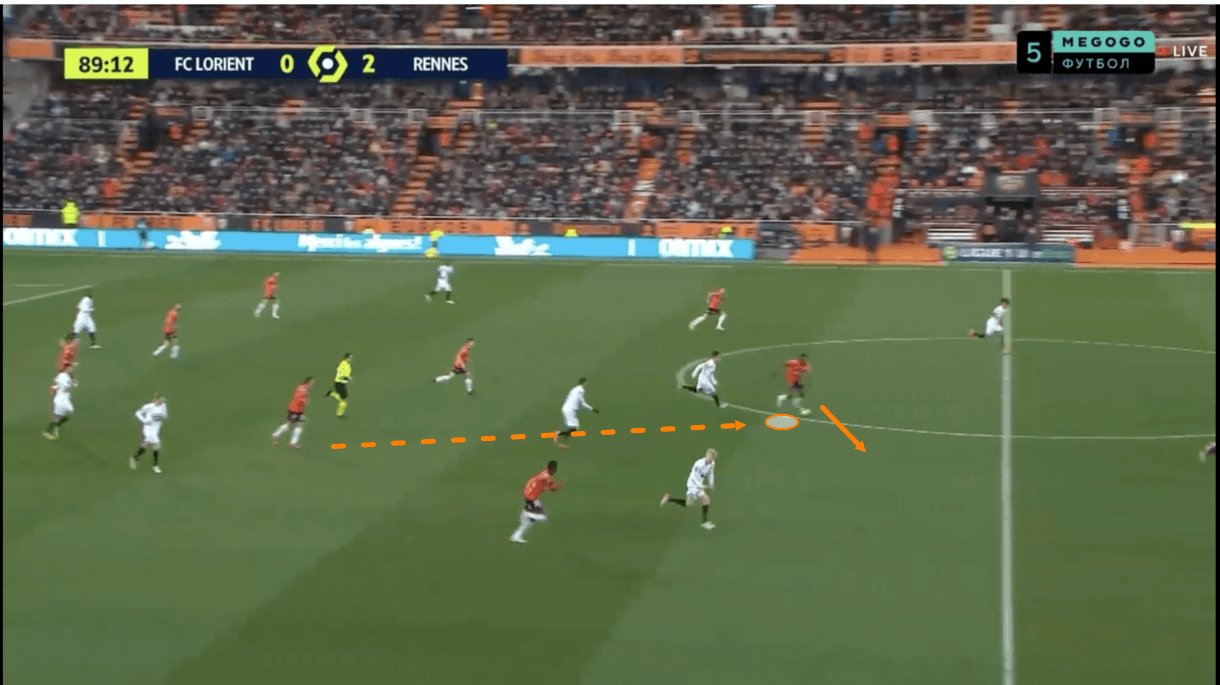
Figures 9-10 show an example of Moffi dribbling from a deeper position, with the backline still positioned in front of him rather than receiving with space to drive into behind the backline. The Lorient attacker is an excellent asset for his side when he receives the ball with space to attack. He’s an excellent, powerful runner and can drive his team forward into the box and a goalscoring position. However, Moffi has some clear issues when dribbling from a deeper position, with bodies in front of him, as was the case in this example.
Firstly, here he receives a slightly weaker pass than the pacey, driven passes he can receive when the ball is sent into a channel for him to chase down. In this situation, Moffi can’t really build up much speed before taking the ball into his control and so must control the ball first before then looking to build speed. This kind of situation can really highlight his poor acceleration. Additionally, when Moffi looks to quickly build speed after receiving the ball deeper, there has been some examples of him failing to get the ball out of his feet, caught under him, and thus made easier for the opposition to steal the ball back.
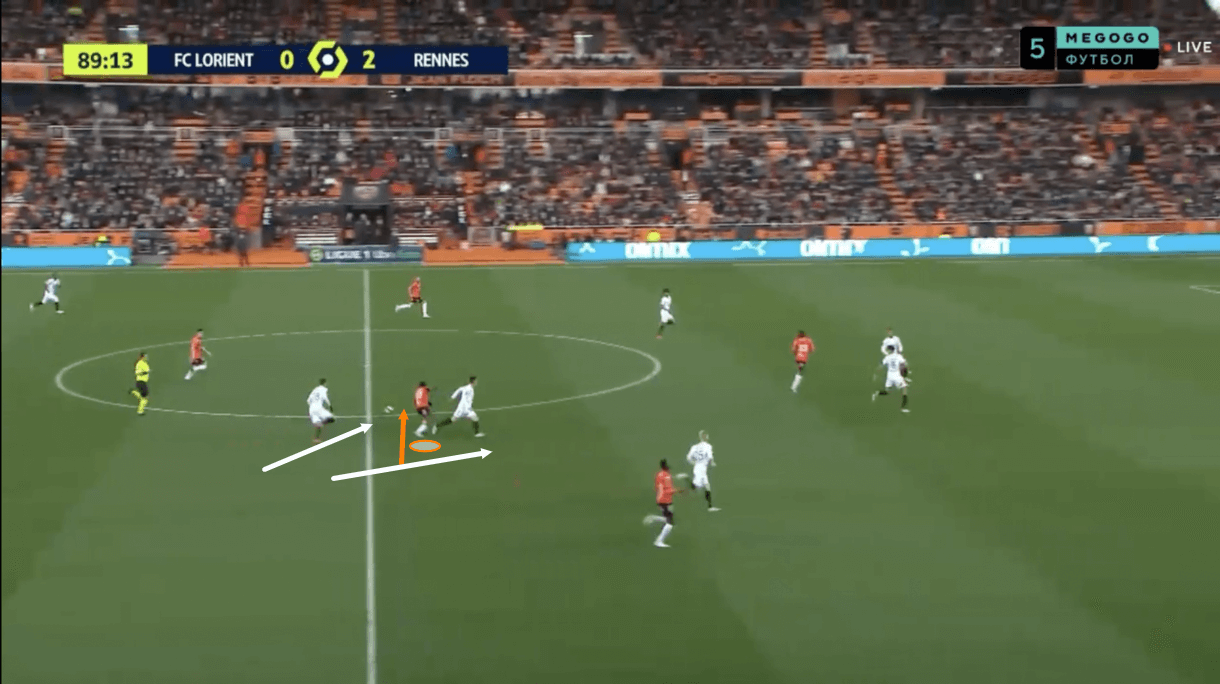
As this particular passage of play moves on into figure 10, we see that one of the Rennes midfielders who was chasing Moffi has actually caught up with the Lorient attacker and got back in front of him as a result of his acceleration troubles and issues with getting the ball out from under his feet on receiving the pass in figure 9, leading to the attacker now being forced to try and beat the Rennes player in a 1v1 duel.
In his attempts to do so, Moffi performed a chop and attempted to exit inside via the centre of the pitch — it’s common to see Moffi perform a chop like this to cut inside onto his stronger left foot when inside the box to set up a shot and he tends to perform that one quite well. However, on those occasions, Moffi is usually moving slightly slower than he was here and has got slightly more control over the ball than he had here. On this occasion, we know he’d just been trying to build pace quickly while he’d been moving out towards the wing, so it’s quite a sharp turn he was attempting to make. Ultimately, the chop takes the ball away from Moffi as he wasn’t agile enough to turn at pace and follow the ball into midfield. As a result, the trailing opposition midfielder was able to regain possession inside the centre circle to kickstart a counter-attack of their own.
So, this passage of play highlights the negatives in Moffi’s dribbling game when faced with trying to beat opposition players 1v1 or carry the ball from deeper. Moffi has some impressive technical dribbling abilities but in general, you don’t want him to be faced with carrying the ball past players — he’s much more useful hanging out on the defenders’ shoulders, making runs in behind where he can receive and use his best skill, his powerful carrying ability, to progress the team forward.
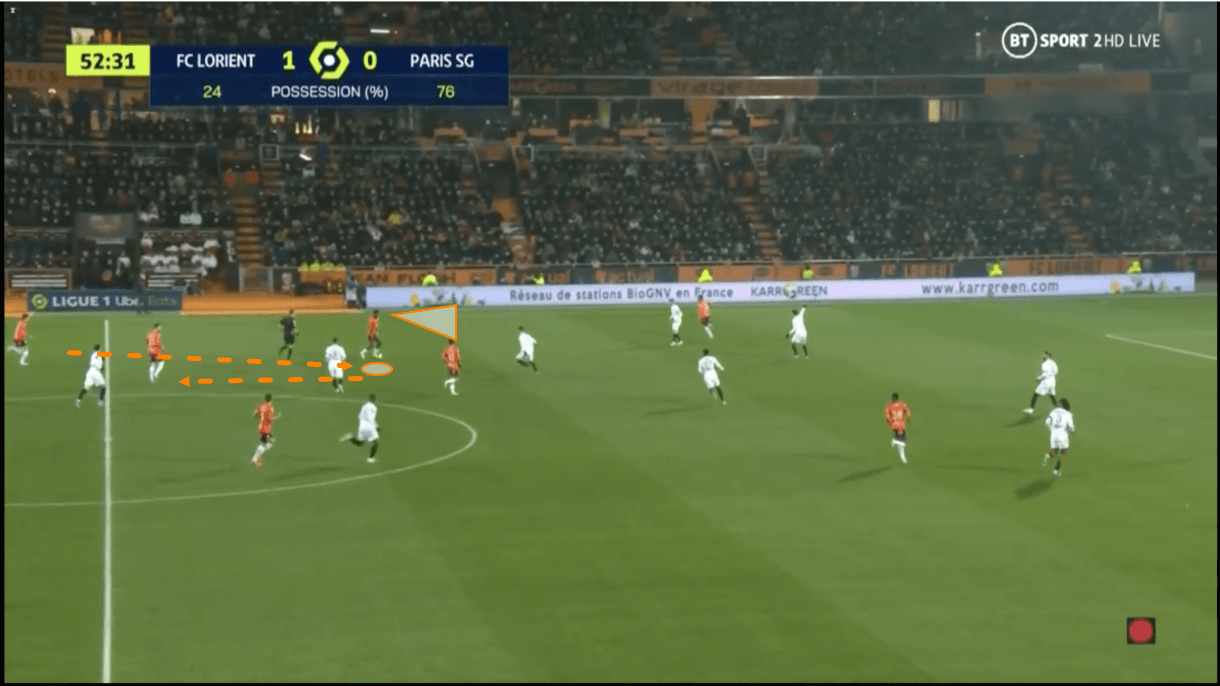
Similarly, Moffi can end up in a deep position, as he did in figure 11 versus PSG, tasked with either carrying the ball forward or playing a line-breaking forward pass. As mentioned earlier in this analysis, while the Nigerian is good at providing a link-up option for teammates inside the final third and this is a strength of his game, he’s not a creative passer who’s going to split the defence apart with a through ball. In a situation like we see in figure 11, you’d much, much rather have Moffi as a runner than have him as the ball carrier. He and his team should aim to minimise the number of times the attacker finds himself in this kind of position and situation, as it’s not a dynamic that best suits Lorient at all.
On this occasion, none of the runs available to Moffi gave him much of an option and he may have wished he had himself to pass to making runs on the shoulder of the backline or even backing into the defenders to create problems that way. As a result, the 22-year-old opted to play a backwards pass and get himself back upfield, which was a wise decision from the attacker who recognised the difficulties associated with moving forward on this occasion, as well as his own limitations, and made a safe call.
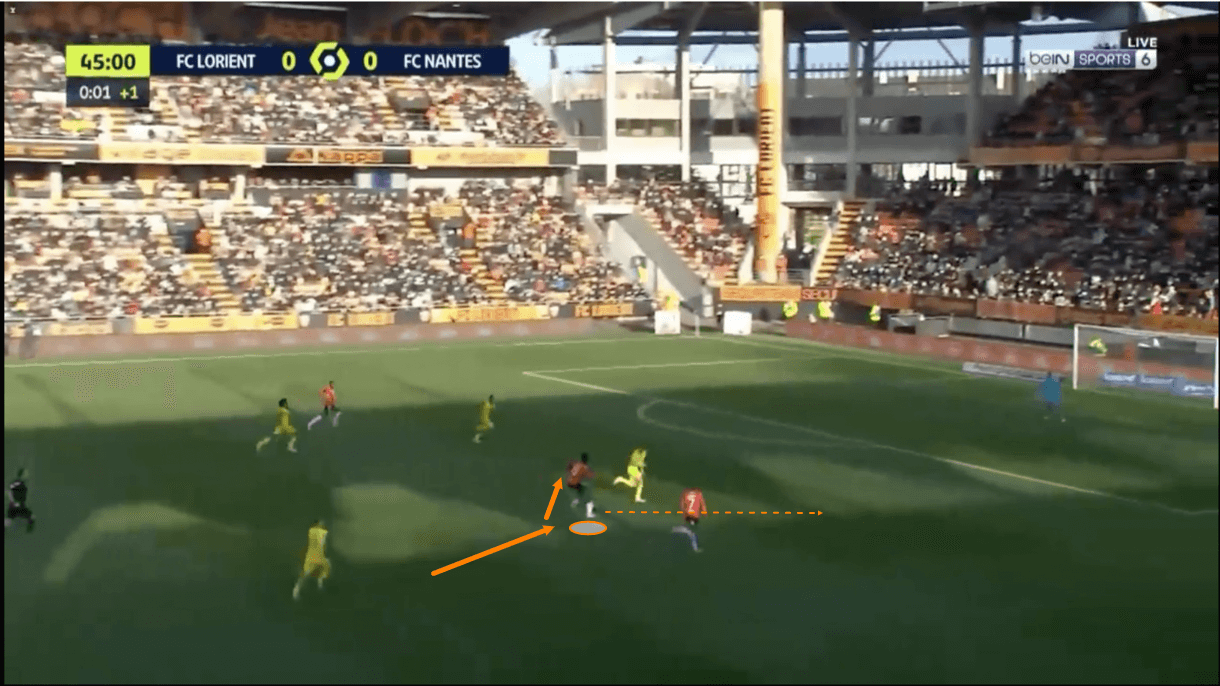
In figures 12-13, we see an example of what I’d determine to be some fairly poor decision-making from the Lorient attacker when approaching the final third. Firstly, in figure 12 we see Moffi carrying the ball into the final third, with Lorient going into a potential 3v2 versus the opposition backline at this moment. While the attacker had one option on his outside running into space, he opted to cut inside onto his stronger left foot and go it alone instead of taking that overlapping option. This wouldn’t be a problem if he had the pace, agility and technical quality to really drive at this defender and go past him but that wasn’t the case for Moffi here.
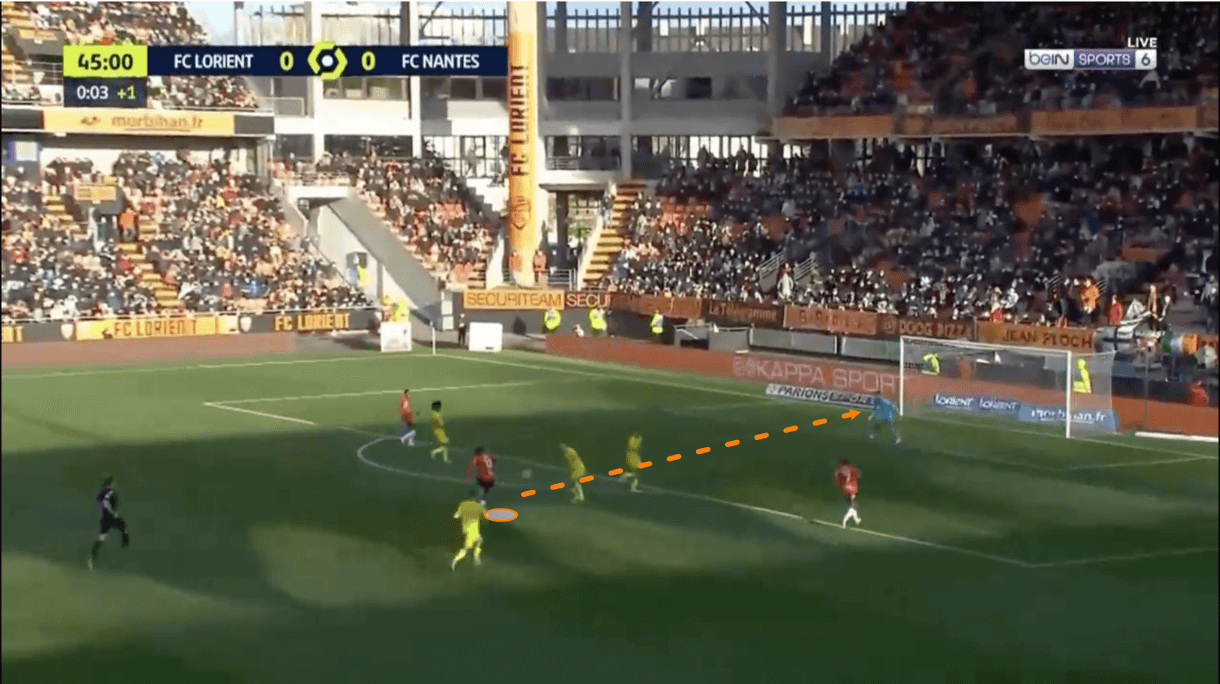
Instead, passing up on the possible pass out to the teammate overlapping on the right allowed another opposition defender to get back behind the ball, leading to another body being put in front of the ball carrier. With the pass out to the overlapping man on the right now covered, Moffi was forced into the long shot which was on target but failed to really test the ‘keeper and resulted in the attack breaking down.
There have been plenty of examples of situations like this in 2021/22 when Moffi’s decision-making in the final third has been a little questionable, which is pretty normal for a 22-year-old forward who’s still developing to become the best version of himself in the game. One way in which he can develop in the future is to get his head up more frequently in the final third when in situations like this and considering other options than going it alone, especially when he’s not the kind of player who generally succeeds at carrying the ball past defenders and may have performed better here had he sent the ball out to the wider attacker and bought himself time to get into a dangerous position in the box off the ball, where he could then provide a passing option for the overlapping teammate.
Of course, hindsight is 20/20 and in-game, things move fast but that little bit of extra consideration to the movement around him and the best possible course of action for him and the team could make a big difference in situations like this.
Conclusion
It’s all about creating as many of the kind of situations in which Moffi thrives and minimising occurrences of scenarios in which he struggles for the attacker and his team, who are struggling following his drop off in finishing performance this term. Moffi is not a target man but an excellent provider of offensive depth, he scores most of his goals after being played through behind the backline and allowed to run off the defender’s shoulder. However, his off-the-ball movement and ability to position himself well in the box, in general, is impressive and he’s also good at providing a crossing threat, both for low and high crosses when his team is in the final third. As a result, I feel Moffi has plenty of skills to suit different styles of play as a centre-forward and finisher, though you’d probably lean more towards a counter-attacking style. I believe his movement and positioning would make him a good option for a team that’s good at creating opportunities via, for example, low driven or cutback crosses as well, however.
The attacker’s big strengths, and the reasons Pélissier remains a firm believer in him, lie in his intelligent offensive movement, positioning, powerful running ability and strength. Thanks to these strengths — especially the first two — I believe Moffi will continue to generate lots of goalscoring opportunities this season and I think it’s just a matter of time before things turn around and he starts taking those opportunities. However, he does have some clear areas of improvement and even some weaknesses in terms of using his size and strength better, creative passing, ability to beat players with a dribble and acceleration.

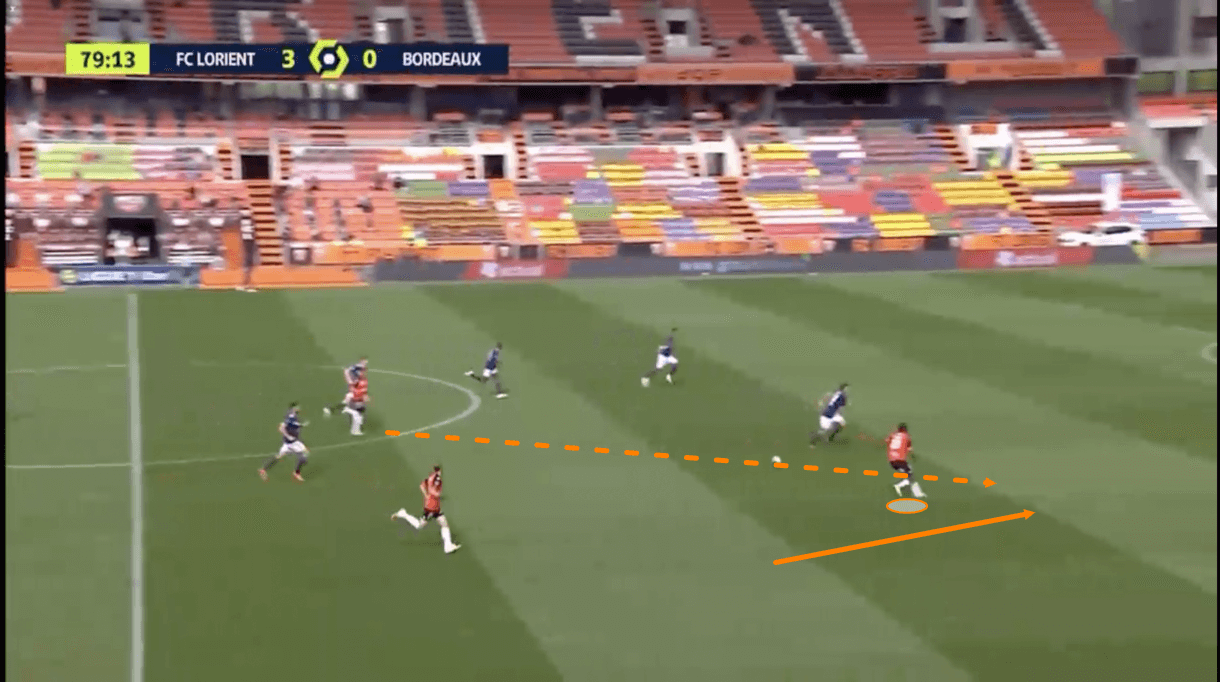



Comments